Work done by a force, energy, power;
- Books Name
- Science Made Easy Science Book
- Publication
- Science Made Easy
- Course
- CBSE Class 9
- Subject
- Science
Introduction
→ The energy for the ‘life processes’ comes from food. Activities like playing, singing, reading, w
thinking, jumping, cycling and running requires energy.
Work
Work done on an object is defined as the product of the magnitude of the force acting on the body and the displacement in the direction of the force.
W = F.s
If a force acting on a body causes no displacement, the work done is 0. For example, pushing a wall.
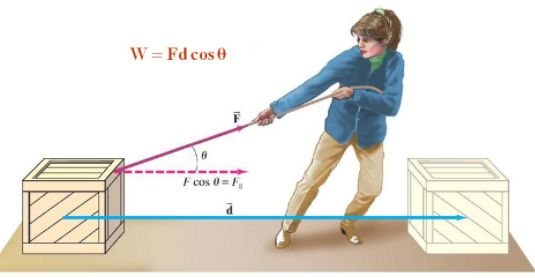
Two conditions need to be satisfied for work to be done:
(i) A force should act on object
(a) The object must be displaced
Work = Force x Displacement
Unit of workdone = Joule = Newton x metre
1 Joule work is said to be done when 1 Newton force is applied on an object and it shows the displacement by 1 meter.
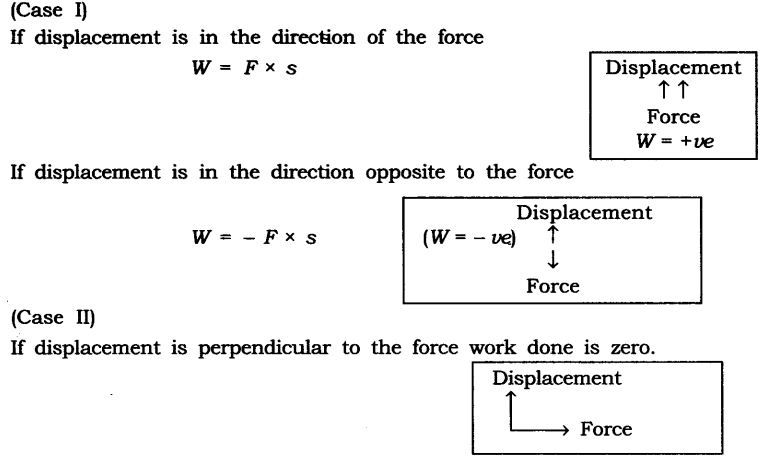
Energy
Energy is defined as the ability to do work. Its unit is the same as that of work.
SI unit of energy or work = Joule (Nm)
Energy has different forms: Light, heat, chemical, electrical or mechanical.
Mechanical energy is the sum of:
(i) Kinetic energy (K.E)
(ii) Potential energy (P.E)
Power
The rate of doing work or the rate of transfer of energy is called power. It is denoted by P
⇒ P = Wt
SI unit is Watt (J/s).
Average power = Total energy consumed / Total time taken
The commercial unit of power is kWh i.e. energy used in 1 hour at 1000 Joules/second.
1KWh = 3.6×106 J
kinetic and potential energy
- Books Name
- Science Made Easy Science Book
- Publication
- Science Made Easy
- Course
- CBSE Class 9
- Subject
- Science
Kinetic Energy
Objects in motion possess energy and can do work. This energy is called Kinetic Energy.
F = ma.
Also W = F.s
⇒ From the 2nd equation of motion v2−u2=2as,
⇒ we get s = v2−u2 / 2a
Substituting equation for work done by a moving body,
⇒ we get W =m.a * v2−u2 / 2a
Or
⇒ Kinetic Energy = K.E= 1/2 mv2 (taking initial velocity u=0)
When two identical bodies are in motion, the body with a higher velocity has more K.E.
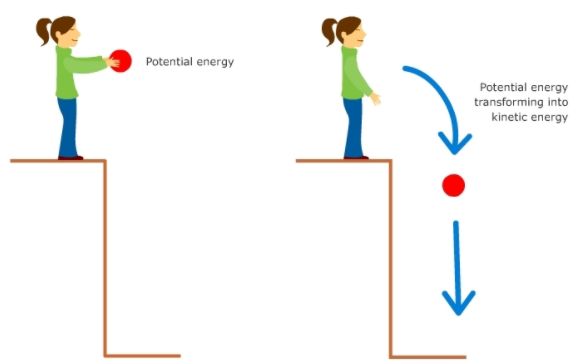
Work-energy theorem
The work-energy theorem states that the net work done by a moving body can be calculated by finding the change in KE.
⇒ Wnet = KEfinal− KEinitial
⇒ Wnet = 1/2 mv2
Factors affecting kinetic energy
- Mass
- Velocity
- Momentum
Potential Energy
Energy can get stored in an object when work is done on it.
For example, stretching a rubber string. The energy that is possessed by a body by virtue of its configuration or change in position is known as Potential Energy.
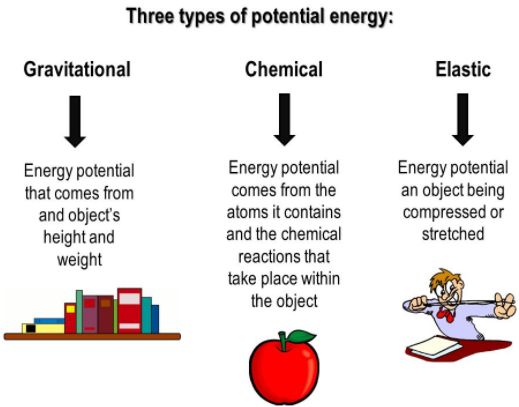
The potential energy of an object at a height.
When an object is raised to a certain height, work is done against gravity to change its position. This energy is stored as Potential Energy.
⇒W = F.s
⇒F = ma
In the case of increasing the height, F = mg
Therefore, W (P.E) = mgh
⇒ ΔPE = mg(hfinal - hinitial )
law of conservation of energy
- Books Name
- Science Made Easy Science Book
- Publication
- Science Made Easy
- Course
- CBSE Class 9
- Subject
- Science
Law of Conservation of Energy
Law of conservation of energy states that energy can neither be created nor destroyed, but can be transferred from one form to another. The total energy before and after the transformation remains constant.
For example: consider a ball falling freely from a height.
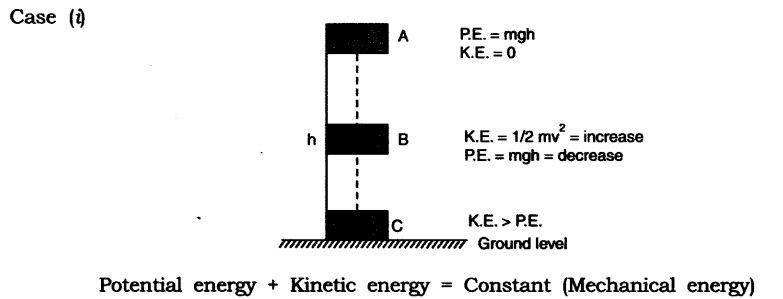
Potential energy + Kinetic energy = Constant (Mechanical energy)
A body of mass ‘m’ is raised to height ‘h’ at A its potential energy is maximum and kinetic energy is 0 as it is stationary.
When body falls at B, h is decreasing hence potential energy decreases and V is increasing hence kinetic energy is increasing.
When the body is about to reach the ground level, h = 0, v will be maximum hence kinetic energy –> potential energy
Decrease in potential energy = Increase in kinetic energy
This shows the continual transformation of gravitational potential energy into kinetic energy.
1. Introduction Part 1
- Books Name
- Science Made Easy Science Book
- Publication
- Science Made Easy
- Course
- CBSE Class 9
- Subject
- Science
Introduction
→ The energy for the ‘life processes’ comes from food. Activities like playing, singing, reading, w
thinking, jumping, cycling and running requires energy.
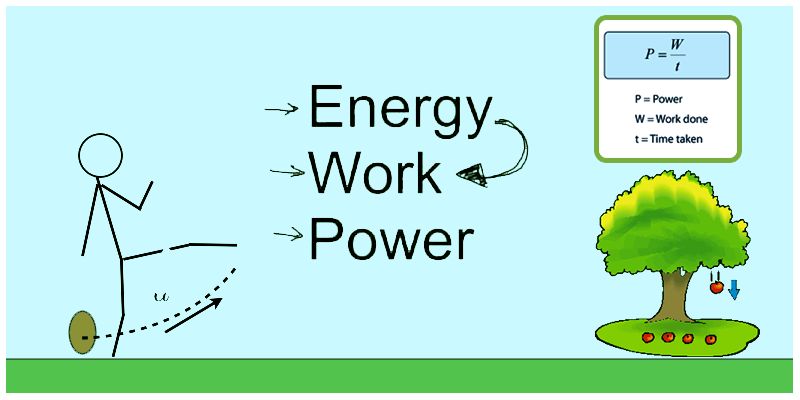
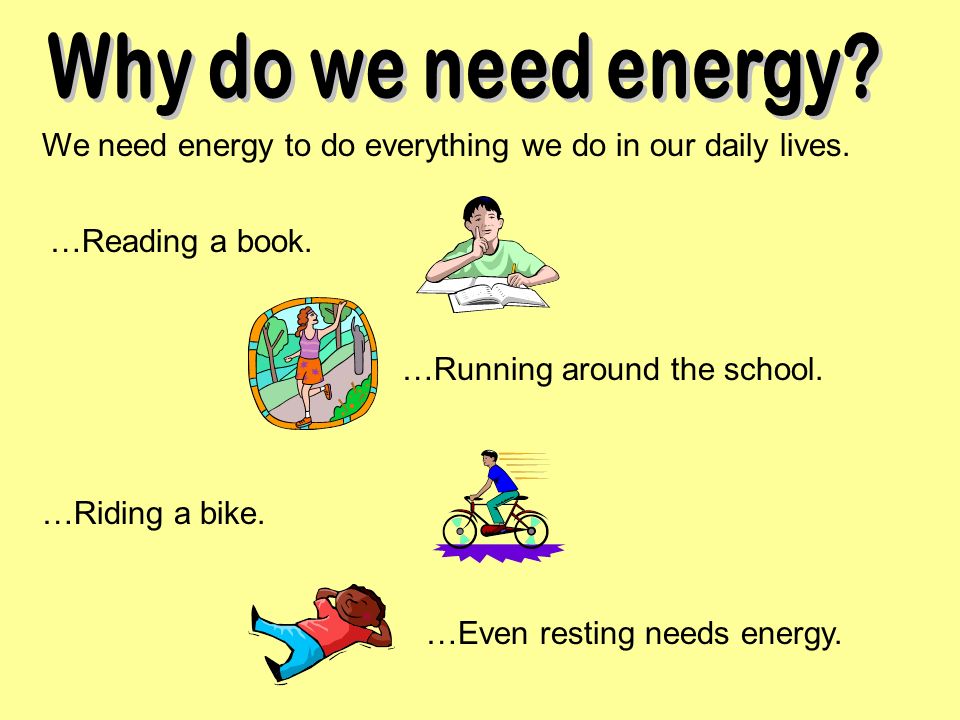
2. Types of Work
- Books Name
- Science Made Easy Science Book
- Publication
- Science Made Easy
- Course
- CBSE Class 9
- Subject
- Science
Work
Work done on an object is defined as the product of the magnitude of the force acting on the body and the displacement in the direction of the force.
W = F.s
If a force acting on a body causes no displacement, the work done is 0. For example, pushing a wall.
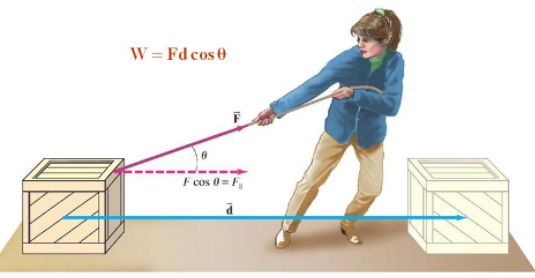
Two conditions need to be satisfied for work to be done:
(i) A force should act on object
(a) The object must be displaced
Work = Force x Displacement
Unit of workdone = Joule = Newton x metre
1 Joule work is said to be done when 1 Newton force is applied on an object and it shows the displacement by 1 meter.
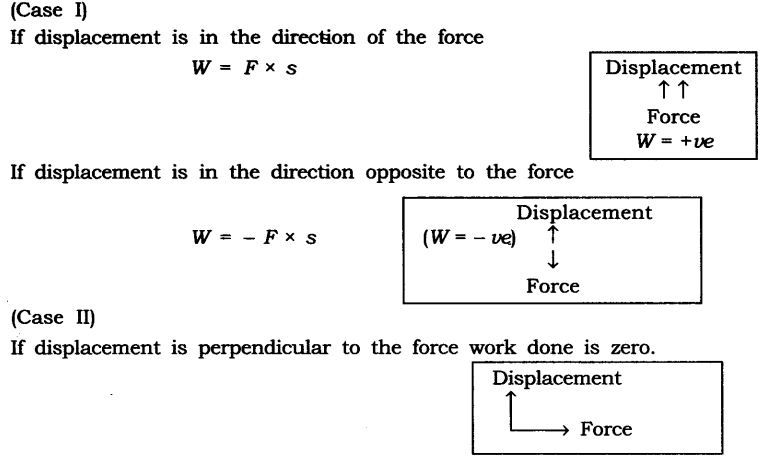
3. Introduction Part 2
- Books Name
- Science Made Easy Science Book
- Publication
- Science Made Easy
- Course
- CBSE Class 9
- Subject
- Science
Energy
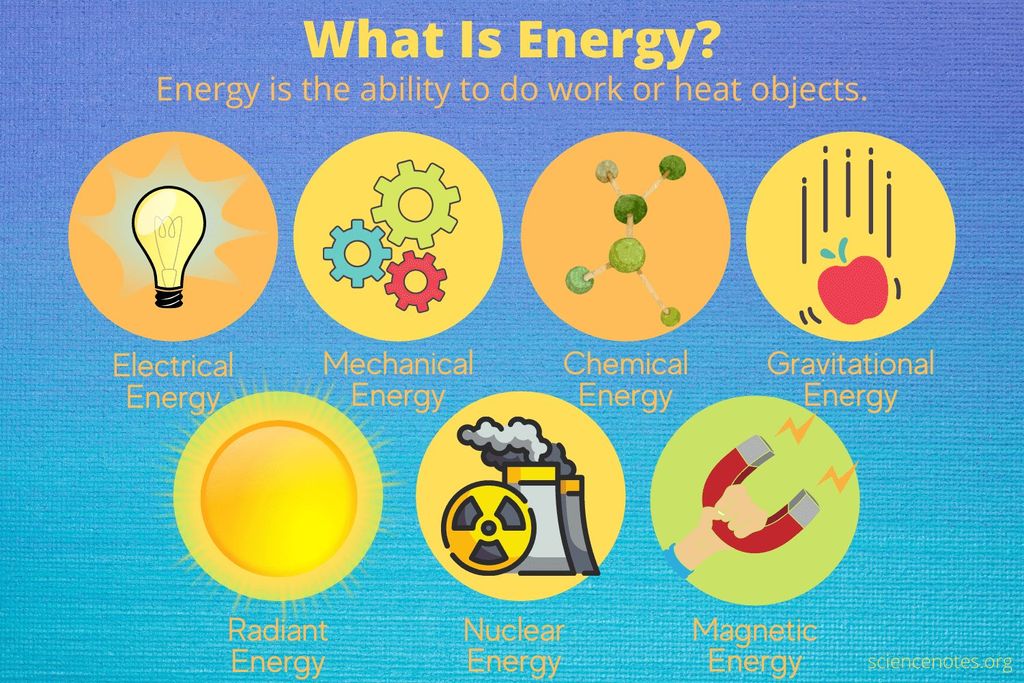
Energy is defined as the ability to do work. Its unit is the same as that of work.
SI unit of energy or work = Joule (Nm)
Energy has different forms: Light, heat, chemical, electrical or mechanical.
Mechanical energy is the sum of:
(i) Kinetic energy (K.E)
(ii) Potential energy (P.E)
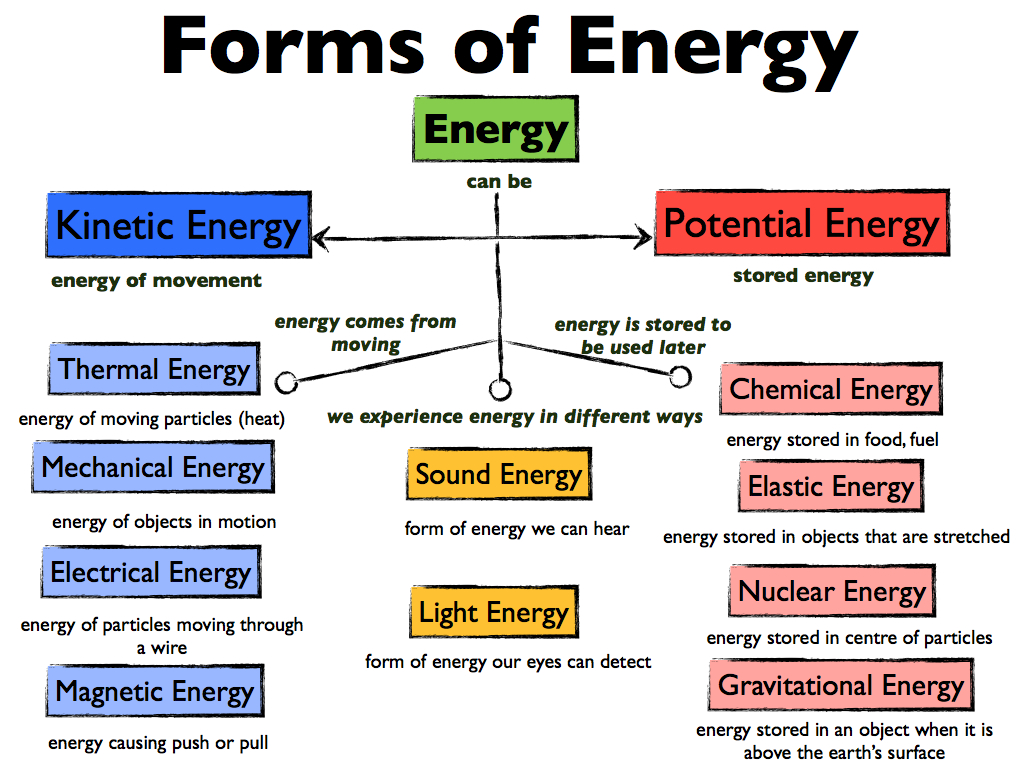
Kinetic Energy
Objects in motion possess energy and can do work. This energy is called Kinetic Energy.
F = ma.
Also W = F.s
⇒ From the 2nd equation of motion v2−u2=2as,
⇒ we get s = v2−u2 / 2a
Substituting equation for work done by a moving body,
⇒ we get W =m.a * v2−u2 / 2a
Or
⇒ Kinetic Energy = K.E= 1/2 mv2 (taking initial velocity u=0)
When two identical bodies are in motion, the body with a higher velocity has more K.E.
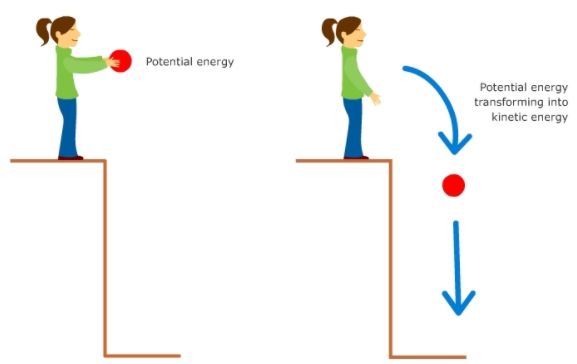
Work-energy theorem
The work-energy theorem states that the net work done by a moving body can be calculated by finding the change in KE.
⇒ Wnet = KEfinal− KEinitial
⇒ Wnet = 1/2 mv2
WORK ENERGY THEOREM
- Books Name
- Science Made Easy Science Book
- Publication
- Science Made Easy
- Course
- CBSE Class 9
- Subject
- Science
Work-energy theorem
The work-energy theorem states that the net work done by a moving body can be calculated by finding the change in KE.
⇒ Wnet = KEfinal− KEinitial
⇒ Wnet = 1/2 mv2
FACTORS AFFECTING K.E.
- Books Name
- Science Made Easy Science Book
- Publication
- Science Made Easy
- Course
- CBSE Class 9
- Subject
- Science
Factors affecting kinetic energy
- Mass
- Velocity
- Momentum
POTENTIAL ENERGY
- Books Name
- Science Made Easy Science Book
- Publication
- Science Made Easy
- Course
- CBSE Class 9
- Subject
- Science
Potential Energy
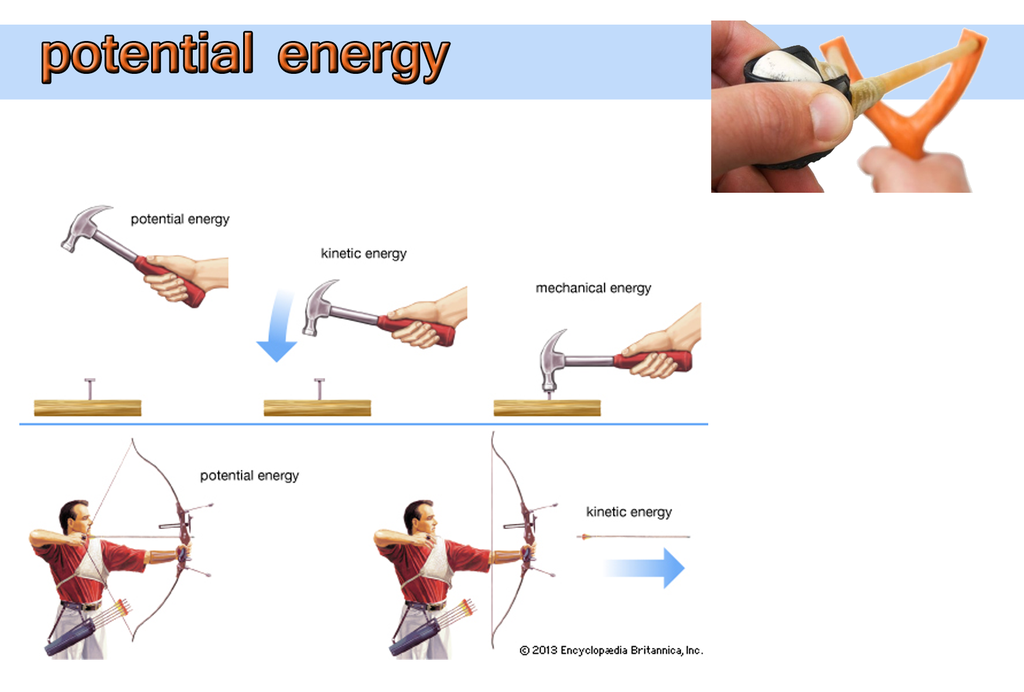
Energy can get stored in an object when work is done on it.
For example, stretching a rubber string. The energy that is possessed by a body by virtue of its configuration or change in position is known as Potential Energy.
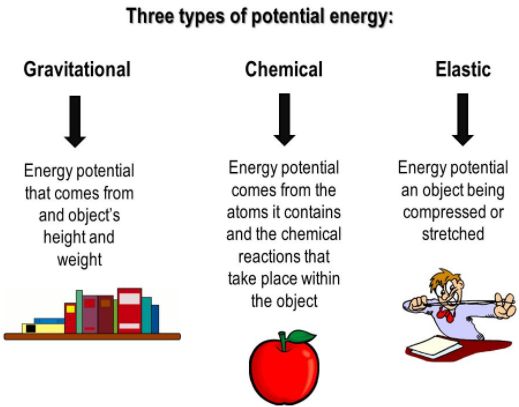
The potential energy of an object at a height.
When an object is raised to a certain height, work is done against gravity to change its position. This energy is stored as Potential Energy.
⇒W = F.s
⇒F = ma
In the case of increasing the height, F = mg
Therefore, W (P.E) = mgh
⇒ ΔPE = mg(hfinal - hinitial )
LAW OF CONSERVATION OF ENERGY
- Books Name
- Science Made Easy Science Book
- Publication
- Science Made Easy
- Course
- CBSE Class 9
- Subject
- Science
Law of Conservation of Energy
Law of conservation of energy states that energy can neither be created nor destroyed, but can be transferred from one form to another. The total energy before and after the transformation remains constant.
For example: consider a ball falling freely from a height.
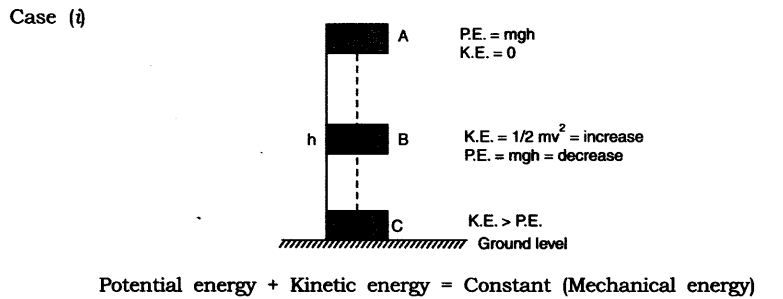
Potential energy + Kinetic energy = Constant (Mechanical energy)
A body of mass ‘m’ is raised to height ‘h’ at A its potential energy is maximum and kinetic energy is 0 as it is stationary.
When body falls at B, h is decreasing hence potential energy decreases and V is increasing hence kinetic energy is increasing.
When the body is about to reach the ground level, h = 0, v will be maximum hence kinetic energy –> potential energy
Decrease in potential energy = Increase in kinetic energy
This shows the continual transformation of gravitational potential energy into kinetic energy.
POWER
- Books Name
- Science Made Easy Science Book
- Publication
- Science Made Easy
- Course
- CBSE Class 9
- Subject
- Science
Power
The rate of doing work or the rate of transfer of energy is called power. It is denoted by P
⇒ P = Wt
SI unit is Watt (J/s).
Average power = Total energy consumed / Total time taken
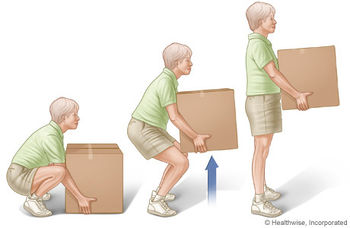
The commercial unit of power is kWh i.e. energy used in 1 hour at 1000 Joules/second.
1KWh = 3.6×106 J

 Science Made Easy
Science Made Easy
